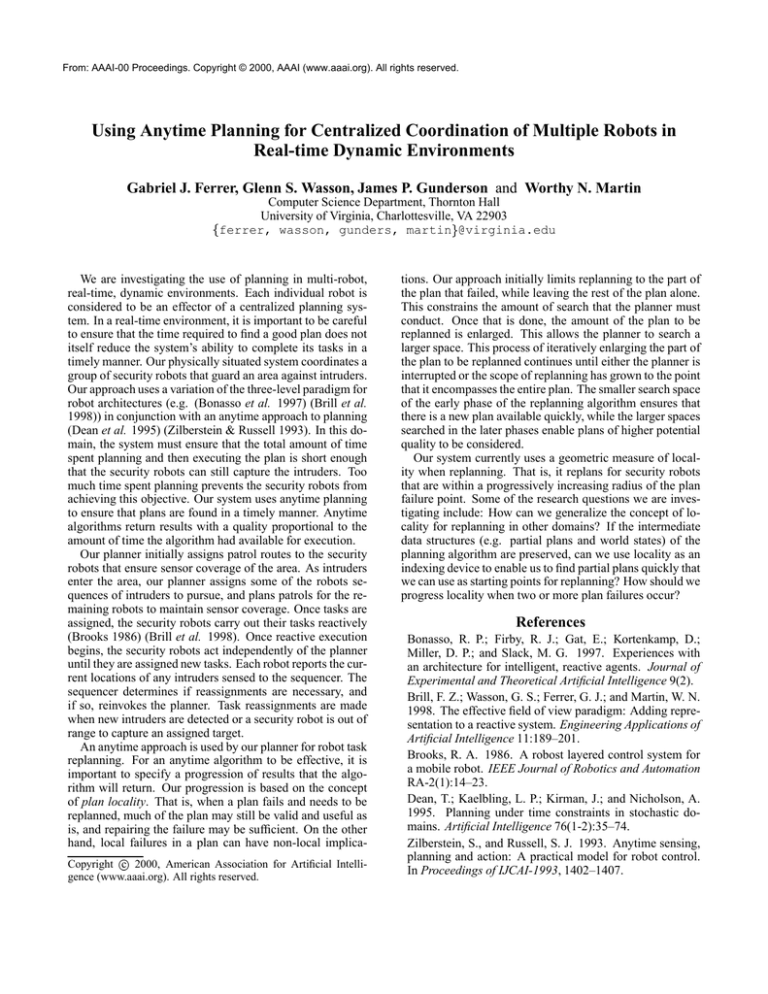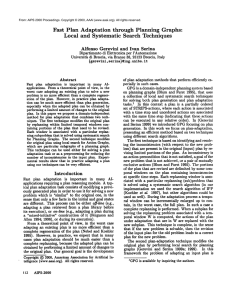
From: AAAI-00 Proceedings. Copyright © 2000, AAAI (www.aaai.org). All rights reserved.
Using Anytime Planning for Centralized Coordination of Multiple Robots in
Real-time Dynamic Environments
Gabriel J. Ferrer, Glenn S. Wasson, James P. Gunderson and Worthy N. Martin
Computer Science Department, Thornton Hall
University of Virginia, Charlottesville, VA 22903
ferrer, wasson, gunders, martin @virginia.edu
We are investigating the use of planning in multi-robot,
real-time, dynamic environments. Each individual robot is
considered to be an effector of a centralized planning system. In a real-time environment, it is important to be careful
to ensure that the time required to find a good plan does not
itself reduce the system’s ability to complete its tasks in a
timely manner. Our physically situated system coordinates a
group of security robots that guard an area against intruders.
Our approach uses a variation of the three-level paradigm for
robot architectures (e.g. (Bonasso et al. 1997) (Brill et al.
1998)) in conjunction with an anytime approach to planning
(Dean et al. 1995) (Zilberstein & Russell 1993). In this domain, the system must ensure that the total amount of time
spent planning and then executing the plan is short enough
that the security robots can still capture the intruders. Too
much time spent planning prevents the security robots from
achieving this objective. Our system uses anytime planning
to ensure that plans are found in a timely manner. Anytime
algorithms return results with a quality proportional to the
amount of time the algorithm had available for execution.
Our planner initially assigns patrol routes to the security
robots that ensure sensor coverage of the area. As intruders
enter the area, our planner assigns some of the robots sequences of intruders to pursue, and plans patrols for the remaining robots to maintain sensor coverage. Once tasks are
assigned, the security robots carry out their tasks reactively
(Brooks 1986) (Brill et al. 1998). Once reactive execution
begins, the security robots act independently of the planner
until they are assigned new tasks. Each robot reports the current locations of any intruders sensed to the sequencer. The
sequencer determines if reassignments are necessary, and
if so, reinvokes the planner. Task reassignments are made
when new intruders are detected or a security robot is out of
range to capture an assigned target.
An anytime approach is used by our planner for robot task
replanning. For an anytime algorithm to be effective, it is
important to specify a progression of results that the algorithm will return. Our progression is based on the concept
of plan locality. That is, when a plan fails and needs to be
replanned, much of the plan may still be valid and useful as
is, and repairing the failure may be sufficient. On the other
hand, local failures in a plan can have non-local implica
Copyright c 2000, American Association for Artificial Intelligence (www.aaai.org). All rights reserved.
tions. Our approach initially limits replanning to the part of
the plan that failed, while leaving the rest of the plan alone.
This constrains the amount of search that the planner must
conduct. Once that is done, the amount of the plan to be
replanned is enlarged. This allows the planner to search a
larger space. This process of iteratively enlarging the part of
the plan to be replanned continues until either the planner is
interrupted or the scope of replanning has grown to the point
that it encompasses the entire plan. The smaller search space
of the early phase of the replanning algorithm ensures that
there is a new plan available quickly, while the larger spaces
searched in the later phases enable plans of higher potential
quality to be considered.
Our system currently uses a geometric measure of locality when replanning. That is, it replans for security robots
that are within a progressively increasing radius of the plan
failure point. Some of the research questions we are investigating include: How can we generalize the concept of locality for replanning in other domains? If the intermediate
data structures (e.g. partial plans and world states) of the
planning algorithm are preserved, can we use locality as an
indexing device to enable us to find partial plans quickly that
we can use as starting points for replanning? How should we
progress locality when two or more plan failures occur?
References
Bonasso, R. P.; Firby, R. J.; Gat, E.; Kortenkamp, D.;
Miller, D. P.; and Slack, M. G. 1997. Experiences with
an architecture for intelligent, reactive agents. Journal of
Experimental and Theoretical Artificial Intelligence 9(2).
Brill, F. Z.; Wasson, G. S.; Ferrer, G. J.; and Martin, W. N.
1998. The effective field of view paradigm: Adding representation to a reactive system. Engineering Applications of
Artificial Intelligence 11:189–201.
Brooks, R. A. 1986. A robost layered control system for
a mobile robot. IEEE Journal of Robotics and Automation
RA-2(1):14–23.
Dean, T.; Kaelbling, L. P.; Kirman, J.; and Nicholson, A.
1995. Planning under time constraints in stochastic domains. Artificial Intelligence 76(1-2):35–74.
Zilberstein, S., and Russell, S. J. 1993. Anytime sensing,
planning and action: A practical model for robot control.
In Proceedings of IJCAI-1993, 1402–1407.






